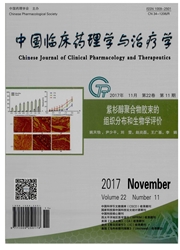

 中文摘要:
中文摘要:
目的:硫化氢(hydrogen sulfide,H2S)为一种假定的血管内皮衍生超极化因子(endothelium—derived hyperpolarizing factor,EDHF),本研究探讨外源性H2S,即外源性假定的EDHF对脑缺血再灌注损伤的影响。方法:采用线栓法复制大鼠局灶性脑缺血(MCAO)再灌注损伤模型,测定动物行为功能、脑组织梗死体积、脑组织含水量、血清乳酸脱氢酶(LDH)活性及丙二醛(MDA)含量,用HE染色法观察脑组织学改变。结果:H2S供体硫氢化钠(NaHS,i.v.)0.195、0.390、0.780mg/kg能明显改善神经功能状态,降低缺血再灌注后脑梗死体积百分比,降低脑含水量,显著地抑制局灶性脑缺血再灌注损伤大鼠血清MDA含量和LDH活性,并不同程度地改善大鼠脑病理组织学的变化。结论:NaHS可明显改善大鼠脑缺血再灌注性损伤,提示外源性ED—HF(H2S)有抗脑缺血再灌损伤作用。
 英文摘要:
英文摘要:
AIM. Hydrogen sulfide (H2S) is one of the supposed endothelium-dependent hyperpolarizing factor (EDHF), the protective effects of exogenous H2 S, namely exogenous supposed EDHF on cerebral ischemia reperfu- sion (I/R) injury was observed in present study. METHODS: Sodium hydrosulfide (NariS) was taken as a donor of He S. Focal cerebral I/R injury was caused by occluding the right middle cerebral artery (MCAO) in rats. The numerical data, which were from infarct volume, neurological deficit, brain water content, malondial- dehyde (MDA) level and lactate dehydrogenase (LDH) activities in serum, were evaluated. HE staining was used to observe brain pathologic changes. RESULTS:0. 195, 0. 390, 0. 780 mg/kg Naris markedly ameliorated the neurological deficit, decreased the percentage of infarct vol- ume, reduced the brain water content, and dra- matically inhibited the cerebral I/R injurer-in- duced increases of LDH activity and MDA con- tent in serum, improved brain pathologic chan- ges in different degrees. CONCLUSION. NariS significantly improved the cerebral I/R injury in rats, this suggests exogenous supposed EDHF (H2S) has a significant protective effect against cerebral I/R injury.
 同期刊论文项目
同期刊论文项目
 同项目期刊论文
同项目期刊论文
 Sirtuin 6 Is Essential for Sodium Sulfide-mediated Cytoprotective Effect in Ischemia/Reperfusion–Sti
Sirtuin 6 Is Essential for Sodium Sulfide-mediated Cytoprotective Effect in Ischemia/Reperfusion–Sti Acetylcholine-and sodium hydrosulfide–induced endothelium-dependent relaxation and hyperpolarization
Acetylcholine-and sodium hydrosulfide–induced endothelium-dependent relaxation and hyperpolarization Protective Effect and Mechanism of Total Flavones from Rhododendron simsii Planch Flower on Cultured
Protective Effect and Mechanism of Total Flavones from Rhododendron simsii Planch Flower on Cultured 期刊信息
期刊信息
